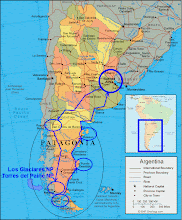
Now in a much drier area – drove west for an hour and half on a laser-shot straight almost perfectly flat road from Rio Colorado to Choele Choel through arid ranch land of low bushes. Infrequently there would be a fancy gate in the fence paralleling the road, allowing a dirt track shooting for a solitary clump of trees on the far horizon. We still saw Shrines of the Red Doghouses along the road, but not as much, and we saw other types as well (there could be a fascinating photo journal just of these roadside shrines).
We went through two produce inspection checkpoints and had to sacrifice our just-bought apples at the first – Bobbie now vows not to buy more fresh food than we can eat in a day. We also went through one provincial checkpoint, but all these stops seemed to be no big deal to either us or the police.
In the afternoon we headed up the valley of the Rio Negro, occasionally passing through dusty pueblos of a few thousand people. As we approached Villa Regina we encountered an extensive barricade system – two double lines of obstructions with an occupied tent camp in between – with the barricades now pulled back to allow vehicles to pass. On the far side I parked the camper and walked back into the tent camp to see if I could find out what was going on. I ran into three people – two women and a guy – painting a protest sign.
“What is all this, please?” I asked in my not-so-hot Spanish.
“Where are you from?” the guy asked.
I wondered what was behind the question but said “The United States”
“First, you have to explain Guantanamo, and then we will tell you” he answered.
But this was mostly in jest, and I learned that they were teachers from all over the area, that this was the last two days of a 40 day protest for better wages and working conditions, that there were other similar protest sites in the region, that maybe tomorrow they would block the road for eight hours, and that they didn’t think the police would try to stop them.
We arrived in Neuquén – a big bustling city in the desert -- in the early evening; and although the book advised there was camping in the city this didn’t work out and we left the town after an hour of driving in Saturday-night traffic. We found a rustic private campsite a few miles outside of Neuquén in Plottier, parked the camper and opened the backdoors to find all the supplied ceramic dishes shattered on the floor. It was a quiet dinner that night.
Writing this in Plottier. Weather cooler here.


No comments:
Post a Comment